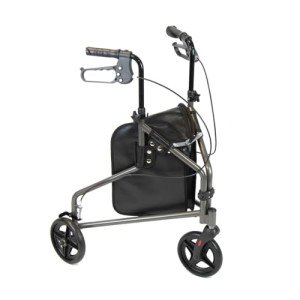The Expert Guide To Rollator Walker
페이지 정보
작성자 Veronica 작성일 25-07-05 04:36 조회 73 댓글 0본문
Rollator Walker Safety: A Comprehensive Guide
As people age or face mobility challenges due to disease or injury, keeping self-reliance often becomes a priority. Rollator walkers, supplying both support and mobility, have actually ended up being indispensable tools for lots of. Nevertheless, while they provide many benefits, guaranteeing safety while utilizing a rollator walker is vital. This short article supplies detailed insights into Rollator Walker Safety; simply click the following web site,, including best practices, common risks, and vital ideas for users and caretakers.
Understanding Rollators
A rollator walker is a mobility device with wheels that permits people to stroll with the assistance of a frame. Unlike standard walkers, rollators normally include:

- Three or four wheels for simpler maneuverability
- Hand brakes for stopping and managing speed
- A seat for resting when needed
- Storage compartments for carrying individual items
These features make rollators appropriate for both indoor and outdoor use, boosting the quality of life for users by supplying a sense of independence.
Benefits of Using Rollator Walkers
- Increased Mobility: Rollators can assist users in moving around securely and easily.
- Assistance and Stability: With a sturdy frame and brakes, they provide essential support when standing or walking.
- Convenience: Many rollators come with padded seats, allowing users to rest as required.
- Convenience: Integrated storage solutions can bring important items, freeing hands for much better balance.
Typical Hazards Associated with Rollator Walkers
While rollators can enhance mobility and safety, they can likewise present threats. Users must be aware of prospective threats to minimize accidents:
- Uneven Surfaces: Rollators may topple if utilized on irregular or sloped terrain.
- Braking Issues: Failing to engage the brakes properly can cause falls.
- Excess Weight: Overloading the storage compartments can impact stability.
- Improper Use: Not using the rollator as intended can result in accidents.
- Poor Maintenance: Neglecting regular examine wheels and brakes could result in failure during use.
Rollator Walker Safety Tips
To improve safety while utilizing rollator walkers, think about the following ideas:
1. Proper Fit and Adjustment
- Height Adjustment: Ensure that the handle height is set to the user's wrist level when standing upright. A correct fit motivates much better posture and control.
- Seat Height: If the rollator has a seat, guarantee it's comfy and available for resting.
2. Regular Maintenance
- Examine Brakes: Make sure hand brakes are operating effectively. Adjust or replace them if necessary.
- Inspect Wheels: Regularly examine wheels for wear and tear, and guarantee they spin easily.
- Take a look at Frame: Check for loose screws or fractures in the frame to ensure it remains sturdy.
| Maintenance Task | Frequency |
|---|---|
| Brake inspect | Weekly |
| Wheel inspection | Monthly |
| Frame evaluation | Regular monthly |
3. Environment Awareness
- Clear Pathways: Keep living areas complimentary from mess and challenges that may position a tripping threat.
- Lighting: Ensure that areas are well-lit to avoid errors, specifically throughout evening hours.
- Avoid Slippery Floors: Be careful on wet or waxed floorings, as they can result in falls.
4. Safe Walking Techniques
- Engage Brakes When Stopping: Always engage brakes before sitting or while resting.
- Use Proper Walking Technique: Move gradually and preserve a constant rate, taking actions that match the rollator's width.
- Balance While Turning: Turn thoroughly, utilizing the rollator for assistance as needed.
5. Seek Assistance
- Include Caregivers: Encourage member of the family or caretakers to assist in navigating tough surfaces or situations.
- Benefit From Community Resources: Many communities provide mobility training for those utilizing walk-assisting gadgets.
FAQs about Rollator Walker Safety
Q1: How do I select the ideal rollator walker?
When picking a rollator, think about the user's weight, height, and intended use. It's likewise necessary to examine for features such as hand brake efficiency and wheel size, which can affect maneuverability.
Q2: Can I use a rollator walker on unequal surface areas?
While rollators can manage a variety of terrains, it is best to avoid steep inclines, gravel, or cobblestones, as these can be unsafe. Stay with flat, smooth surfaces whenever possible.
Q3: How can I prevent falls while utilizing a rollator?
Engaging the brakes when sitting, keeping paths clear, changing your rollator for the proper height, and bearing in mind your surroundings can considerably minimize the risk of falls.
Q4: Are all rollator walkers the exact same?
No, rollators can be found in various types and sizes, developed for different needs. Some may have additional accessories like baskets, while others are lightweight or feature a higher weight capacity.
Q5: Is it safe to carry bags on a rollator?
Constantly bear in mind the weight limitation and circulation of the load. Use the rollator's designated storage options and avoid straining it.
Rollator walkers are important devices that enhance mobility and promote independence for users facing mobility challenges. Nevertheless, guaranteeing safety while using these devices is essential. By comprehending potential threats, adhering to safe practices, and maintaining the walker frequently, users can enjoy the benefits of their rollator with reduced threat. Eventually, the goal is to help with confidence and stability, enabling individuals to browse their world with security and ease. As care providers, member of the family, and neighborhoods prioritize safety, they empower users towards a better, more independent quality of life.
- 이전글 Bunk Beds With Slide: The Ugly Facts About Bunk Beds With Slide
- 다음글 The Reason Why Headphone For Sale Is The Most Sought-After Topic In 2024
댓글목록 0
등록된 댓글이 없습니다.

